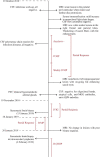A 52-Year-Old Man With Progressive Weakness and Incontinence
- PMID: 35419156
- PMCID: PMC8995596
- DOI: 10.1177/19418744211039586
A 52-Year-Old Man With Progressive Weakness and Incontinence
Abstract
Here we report a challenging case of a 52-year-old man presenting with subacute constipation, urinary retention, impotence, absent Achilles reflexes, and hypoesthesia in S2-S5 dermatomes. We review the clinical decision-making as the symptoms evolved and diagnostic testing changed over time. Once the diagnosis is settled, we discuss the sign and symptoms, additional diagnostic tools, treatment options and prognosis.
Keywords: central nervous system infections; cerebrovascular disorders; clinical specialty; general neurology; medical oncology; myelitis; neurooncology; stroke.
© The Author(s) 2021.
Conflict of interest statement
Declaration of Conflicting Interests: The author(s) declared no potential conflicts of interest with respect to the research, authorship, and/or publication of this article.
Figures



References
-
- Orendácová J, Cízková D, Kafka J, et al. Cauda equina syndrome. Prog Neurobiol. 2001;64(6) 613–637. - PubMed
-
- Eberhardt O, Küker W, Dichgans J, Weller M. HSV-2 Sacral radiculitis (Elsberg syndrome). Neurology. 2004;63(4):758–759. - PubMed
-
- Beristain X, Biagio A. The neurological masquerade of intravascular lymphomatosis. Arch Neurol. 2002;59(3):439–443. - PubMed
-
- Ponzoni M, Ferreri AJM. Intravascular lymphoma: a neoplasm of ‘homeless’ lymphocytes? Hematol Oncol. 2006;24(3):105–112. - PubMed
LinkOut - more resources
Full Text Sources
